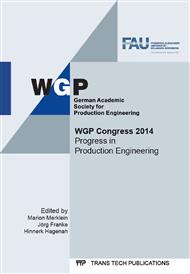[1]
J. Mayr et al, Thermal issues in machine tools, CIRP Annals – Manufacturing Technology 61 (2012) 771-791.
Google Scholar
[2]
M. Weck, C. Brecher, Werkzeugmaschinen - Messtechnische Untersuchung und Beurteilung, dynamische Stabilität, Springer, Berlin, (2006).
DOI: 10.1007/978-3-540-32951-0_4
Google Scholar
[3]
K. Großmann, C. Städel, A. Galant, A. Mühl, Berechnung von Temperaturfeldern an Werkzeugmaschinen - Vergleichende Untersuchung alternativer Methoden zur Erzeugung kompakter Modelle, ZWF 107 (2012) 452-456.
DOI: 10.3139/104.110781
Google Scholar
[4]
T. Luhmann, Close range photogrammetry: principles, techniques and applications, Whittles, (2006).
Google Scholar
[5]
T. Luhmann, Close range photogrammetry for industrial applications, ISPRS Journal of Photogrammetry and Remote Sensing 65 (2010) 558-569.
DOI: 10.1016/j.isprsjprs.2010.06.003
Google Scholar
[6]
K. Großmann, J. Müller, M. Merx, M. Riedel, Untersuchung des thermo-elastischen Verhaltens von Werkzeugmaschinen - Grundlagen der experimentellen Analyse mit Hilfe der selektiven Thermografie, ZWF 108 (2013) 492-497.
DOI: 10.3139/104.110981
Google Scholar
[7]
M. Vollmer, K. -P. Möllmann, Infrared Thermal Imaging: Fundamentals, Research and Applications, Wiley-VCH, Weinheim, (2010).
Google Scholar
[8]
W. Minkina, S. Dudzik, Infrared Thermography: Errors and Uncertainties, Wiley-VCH, Weinheim, (2009).
Google Scholar
[9]
U. Heisel, G. Koscák, T. Stehle, Thermography-Based Investigation into Thermally Induced Positioning Errors of Feed Drives By Example of a Ball Screw, CIRP Annals – Manufacturing Technology 55(1) (2006) 423-426.
DOI: 10.1016/s0007-8506(07)60450-8
Google Scholar
[10]
S. T. Smith, Modelling Hot Bodies: Combined real-time 3D Thermal Imaging for Medical Applications, MSc IT project report, Glasgow University (2002).
Google Scholar
[11]
K. Großmann, A. Galant, M. Merx, M. Riedel, Verfahren zur effizienten Analyse des thermo-elastischen Verhaltens von Werkzeugmaschinen, in: R. Neugebauer, W. -G. Drossel (Eds. ), Innovations of Sustainable Production for Green Mobility – Energy-Efficient Technologies in Production, Reports from the IWU volume 80 (2014).
Google Scholar
[12]
K. Großmann, A. Galant, A. Mühl, Effiziente Simulation durch Modellordnungsreduktion - Thermo-elastische Berechnung von Werkzeugmaschinen-Baugruppen, ZWF 107 (2012) 457-461.
DOI: 10.3139/104.110784
Google Scholar


